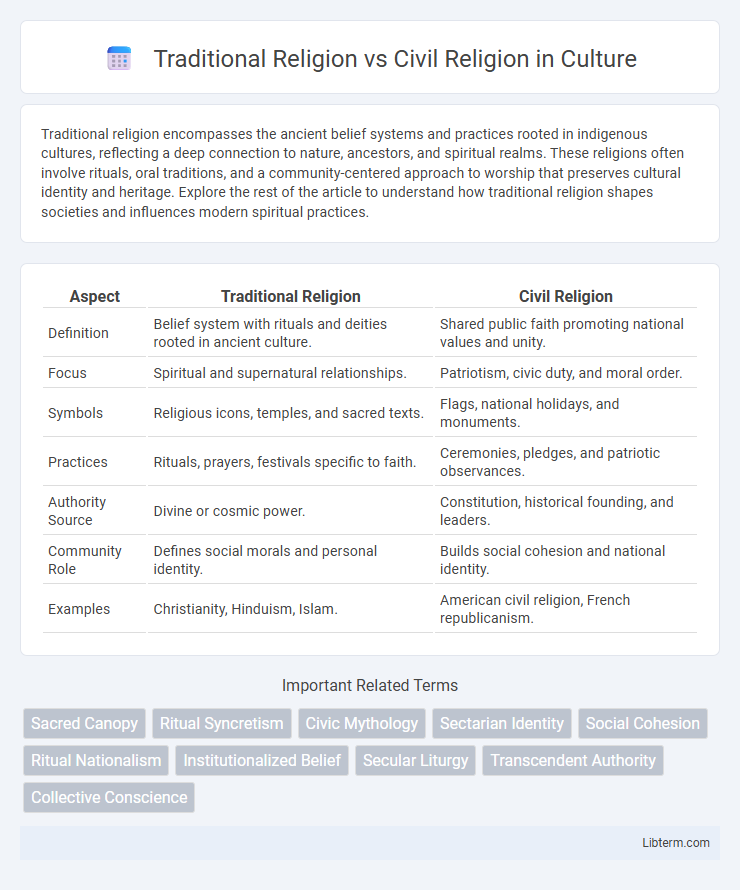Traditional religion encompasses the ancient belief systems and practices rooted in indigenous cultures, reflecting a deep connection to nature, ancestors, and spiritual realms. These religions often involve rituals, oral traditions, and a community-centered approach to worship that preserves cultural identity and heritage. Explore the rest of the article to understand how traditional religion shapes societies and influences modern spiritual practices.
Table of Comparison
| Aspect | Traditional Religion | Civil Religion |
|---|---|---|
| Definition | Belief system with rituals and deities rooted in ancient culture. | Shared public faith promoting national values and unity. |
| Focus | Spiritual and supernatural relationships. | Patriotism, civic duty, and moral order. |
| Symbols | Religious icons, temples, and sacred texts. | Flags, national holidays, and monuments. |
| Practices | Rituals, prayers, festivals specific to faith. | Ceremonies, pledges, and patriotic observances. |
| Authority Source | Divine or cosmic power. | Constitution, historical founding, and leaders. |
| Community Role | Defines social morals and personal identity. | Builds social cohesion and national identity. |
| Examples | Christianity, Hinduism, Islam. | American civil religion, French republicanism. |
Understanding Traditional Religion: Core Beliefs and Practices
Traditional religion centers on ancestral worship, ritual ceremonies, and a deep connection to nature, emphasizing the transmission of cultural values through oral traditions and communal rites. Core beliefs often include the existence of spiritual beings, sacred landscapes, and cyclical time, which shape moral codes and social structures within the community. Rituals such as sacrifices, festivals, and rites of passage serve to reinforce group identity and maintain harmony between the human and spiritual worlds.
The Emergence of Civil Religion: Definition and Features
Civil religion emerges as a set of quasi-religious beliefs and practices that unite a nation through shared symbols, rituals, and values, distinct from traditional religious institutions. Its defining features include a collective reverence for sacred national symbols, the sanctification of foundational historical events, and the integration of moral and patriotic ideals that foster social cohesion. Unlike traditional religion which centers on divine worship and dogma, civil religion functions as a unifying cultural framework reinforcing national identity and communal loyalty.
Historical Roots: Traditional vs. Civil Religion
Traditional religion traces its historical roots to ancient, culturally specific practices and sacred myths passed down through generations, reflecting a community's spiritual and moral values. Civil religion, by contrast, emerges from modern nation-states and is characterized by a set of shared symbols, rituals, and beliefs that unify citizens around national identity and political ideals. While traditional religion centers on divine worship and metaphysical narratives, civil religion functions as a political tool to foster social cohesion and patriotism through secular sacred elements.
Sacred Symbols in Traditional and Civil Religions
Sacred symbols in traditional religions often include artifacts, rituals, and icons deeply intertwined with the community's mythology and spiritual beliefs, such as the cross in Christianity or the Om symbol in Hinduism. Civil religion, by contrast, employs symbols like flags, national anthems, and monuments that embody collective values, patriotism, and civic identity rather than explicit supernatural worship. These civil symbols function to unify diverse populations under shared moral codes and national narratives without reliance on specific theological frameworks.
Rituals and Ceremonies: Comparing Religious Practices
Traditional religion emphasizes rituals and ceremonies deeply rooted in ancient customs, often involving symbolic rites that connect participants to spiritual ancestors and natural cycles. Civil religion incorporates ceremonial practices that promote national identity and unity, such as patriotic rituals, public commemorations, and state-sponsored observances. While traditional religious rituals aim to preserve sacred traditions within a faith community, civil religious ceremonies function to reinforce social cohesion and collective values in a secular or pluralistic society.
The Role of Authority: Clergy vs. Civic Leaders
Traditional religion places authority primarily in the hands of clergy, who interpret sacred texts, conduct rituals, and guide followers in spiritual matters. Civil religion, by contrast, assigns authority to civic leaders who symbolize national values and promote social unity through secular ceremonies and public symbols. This distinction highlights how traditional religious authority is rooted in divine legitimacy, while civil religious authority is grounded in political power and communal identity.
Influence on Social and Political Life
Traditional religion shapes social and political life by reinforcing community values through rituals, moral codes, and shared beliefs that influence laws, customs, and political legitimacy. Civil religion, exemplified in national symbols, ceremonies, and patriotic myths, unites diverse populations under a common identity and supports state authority by sacralizing civic institutions. Both impact social cohesion and political stability, with traditional religion often grounding local customs and civil religion fostering national unity.
Ethics and Morality: Religious vs. Civic Values
Traditional religion grounds ethics and morality in sacred texts, divine commandments, and spiritual teachings that emphasize personal salvation and communal holiness. Civil religion articulates ethical principles through patriotic symbols, national rituals, and shared values promoting social cohesion, loyalty, and public duty. While religious morality centers on transcendental accountability, civic values prioritize collective well-being and legal frameworks for justice.
Conflicts and Coexistence: Interactions Between the Two
Traditional religion and civil religion often conflict when state rituals or symbols clash with deeply held spiritual beliefs, leading to tensions over legitimacy and authority. However, coexistence emerges through shared values, such as patriotism and moral codes, enabling traditional religious groups to participate in civil ceremonies without compromising their doctrines. Negotiating these boundaries frequently results in hybrid practices that blend sacred traditions with national identity, fostering social cohesion despite underlying differences.
Contemporary Relevance: The Future of Religion in Society
Traditional religion, rooted in ancient rituals and sacred texts, continues to influence cultural identity and moral frameworks in many societies, preserving historical continuity and communal values. Civil religion, characterized by shared national symbols, ceremonies, and collective beliefs, fosters social cohesion and patriotism in increasingly secularized or pluralistic contexts. The future of religion in society likely involves an interplay where civil religion complements traditional religious practices to address modern ethical challenges and unify diverse populations.
Traditional Religion Infographic

 libterm.com
libterm.com